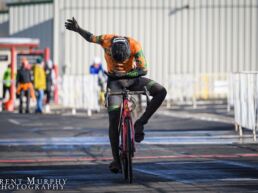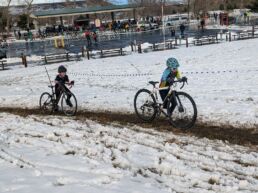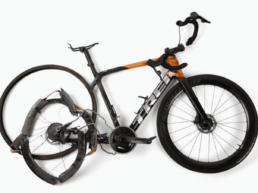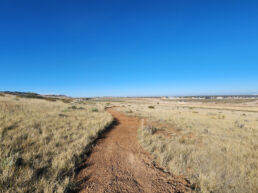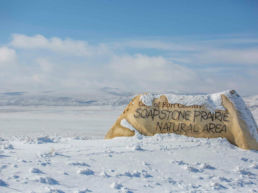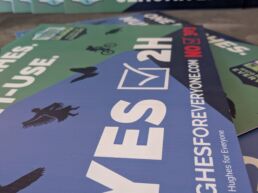Great article about Fort Collins cycling in the 1800’s. Written by Meg Dunn for Forgotten Fort Collins. http://forgottenfortcollins.com/
This Laufmaschine (“running machine”) is from around 1820 and is on display in the Kurpfälzisches Museum in Heidelberg, Germany. The German Baron Karl von Drais invented this early bicycle in 1817. (Text and image from WikiMedia and licensed for reuse.)
The first “bicycle” was invented in 1817 by Karl von Drais. He called it a Laufmaschine (German for “running machine”) and it was more like the striders that are popular with very young children today as it had no pedals but was operated by pushing off from the ground. It wasn’t until the 1860s that pedals were added. This next generation of bikes is often referred to today as the penny farthing, although at the time it was simply known as a high wheeler or ordinary bike. But they weren’t particularly stable. It wasn’t until the 1880s that the “safety bike” came out. These are essentially the machines that we’ve come to think of today as regular ‘ole bicycles.

Laurie Evans (of the Poudre Landmarks Foundation) and Sylvia Cranmer (of Bike Fort Collins) pose with a penny farthing that is part of the Vintage Bike Museum without walls. As the name implies, the “museum” travels about from location to event to another location. This photo was taken in front of Cranknstein before the bicycle was moved to the Masonic Temple for the Time Travelers Ball last autumn that was put on by the Poudre Landmarks Foundation. This penny farthing is a Rudge America replica (only the front hub is original) and was made in Czechoslovakia in the late 1990s/early 2000s. (Photo taken by Jennifer Beccard.)
It’s unlikely that any of the soldiers that were stationed in Camp Collins brought a bicycle along with them. The first local mention of bicycles that can be found through the ColoradoHistoricNewspapers.org website is from March 18, 1880, and it’s simply a reference to how many bicycles and bicycle clubs were purportedly in England at the time. But over the 1880s, there’s a little mention here or there that indicate a rise in the use of bicycles in the area.
“A bicycle is much easier to master than one would think. The first thought in getting on one is quick calculation. The calculation is to solve the problem of which way one will fall. The solution is a tumble, being a combination of every conceivable way of getting down with a vim and bruises. One soon masters the thing.” — April 7, 1881 Fort Collins Courier (which was reprinting an article from a Washington paper)
In 1882, there were ads placed by a Denver shop in the Courier advertising, “Fishing Tackle, Base Ball Goods, Scroll Saws, Bicycles, Croquet, Archery, Dumb-Bells, Indian Clubs, Boxing Gloves, Roller Skates, Lathes, Tools, Tricks, Games, Sporting, Gymnasium, and Theatrical Goods of all kinds.” Though bicycle hose (special clothing for bicycling) was sold locally by the late 1880s, there doesn’t appear to have been a local shop that sold bikes until the early 1890s.
Early mentions of local cycling activity often centered around cyclists passing through town and locals trying to learn to use the new contraptions.
“M. V. B. Gillette, of Greeley, arrived in town this afternoon on his bicycle, riding the entire distance–about 30 miles–in four hours, including rests. He will go up above Livermore tomorrow, where he has some business to transact.” — December 28, 1882 Fort Collins Courier
“Two adventurous wheelmen named, respectively, George W. Thayer and J. A. Hasley, the former from near Hartford, Connecticut and the latter from Milwaukee, Wisconsin, passed through town Monday on their bicycles bound for San Francisco, California. Mr. Thayer, whose father is an old time Connecticut friend of Wm. B. Miner, left home April 23, and has traveled something over 2,300 miles, as indicated by a cyclometer attached to his bicycle. He met Mr. Hasley in Denver and the two will make the remainder of the journey together. Mr. Thayer is also a friend and school mate of C. E. Lull, the popular College avenue druggist.” — 1 July 1886 FCC
“M. E. Stepensen, the taxidermist, applies his spare time learning to curb the treacherous gyrations of the bicycle.” — March 8, 1883 Fort Collins Courier
By the summer of 1885, there was talk of starting a bicycle club in town. Both Laramie and Denver already had them. (Denver’s was called the “Colorado Wheel Club” as bicycles were often referred to simply as wheels.) And cyclists in both cities were in contact with folks in Fort Collins, encouraging them to attend races as well as to host them. Soon bicycle races were being included in the local Independence Day festivities as well as at the Larimer county fair. The June 17, 1886 Fort Collins Courierannounced that the winner of the bike race on the 4th of July would receive $2, and the 2nd place winner would get a hat.

Clara Preston Halderman at Preston Farm with her bicycle in the 1890s. The Preston Farm was one of the first “saves” added to Colorado Preservation Inc.’s “Most Endangered Places” list. It was landmarked in 1998 and still stands near the intersection of Harmony and Ziegler. (Photo from the Fort Collins Archive – H01570.)
In reading through old Fort Collins newspapers, it’s sometimes difficult to tease out what were national issues and which hit home locally. “Scorching” appears to have been a problem in other cities, but it’s unclear if it was any bother here. Scorching was when the cyclist would lean forward, hunching over the handlebars, and come barreling down hills, occasionally scaring, and sometimes even running over, pedestrians, horses, and barnyard fowl. Although the Poudre Valley has plenty of hills upon which young cyclists could scorch, most didn’t have any people or animals at the base, so it probably wasn’t a problem. That didn’t stop one local newspaperman from having some fun with words in the paper…
“A bicycle ordinance that can scorch through the council and not be punctured in the courts is what the wheelmen are looking out for as the next model.” — 7 Oct 1897 Fort Collins Courier
There does appear to be one national issue that was also a problem in Fort Collins as well and that was involving bicyclists on sidewalks. With dirt and gravel streets, full of ruts, horse manure, and either dust or mud (depending on the weather) many cyclists preferred the comparatively smoother ride provided by the sidewalks. This caused conflicts with pedestrians and in 1888 the city council and mayor, J. C. Evans, passed an ordinance forbidding “any bicycle, tricycle, velocipede or other riding machine or apparatus upon or along any of the public sidewalks or street crossings within the city of Fort Collins.” (July 5, 1888, Fort Collins Courier)
The first mention of local bicycle sales that I found was in the May 14, 1891 Courierand was announced by Alden & Co. It appears that cycling took off in the town at that point, with the newspaper announcing in 1893 “There are about fifty bicyclers in Fort Collins ranging from fairly good to expert wheelmen and wheelwomen.” (May 25, 1893, Fort Collins Courier)
“Charles Wight, who claims to hail from Fort Collins, is now languishing in our county bastile because he coveted Prof. Bybee’s bicycle, and so coveting, did steal the same. It was found in Denver at the U. P. Depot, by Frank Ewing, who instructed an officer to nab the party who claimed it–as it was stolen.” — from the Greeley Democrat, reshared by the Fort Collins Courier on 1 June 1893.
Of course, growing popularity brought with it other problems. Thefts were also occasionally announced in the paper.

The popularity of bicycles led to all sorts of ingenuous uses for them as shown in this June 25, 1896 Fort Collins Courier article.
Fort Collins wasn’t the only Northern Colorado town to see new wheels on the road.
“Bicycles are becoming numerous in our town and vicinity, and excursions on these curious vehicles is an every day occurrence. The latest to enter the lists as safety riders are Mrs. Harrison Teller, Mrs. Geo. Briggs and her daughter, Minnie.” — published in the June 8, 1893 Fort Collins Courier under the section from the New Windsor correspondent. (At some point the town was no longer “new” and today we simply call it Windsor.)
During this period in history, the women’s suffrage movement was gaining steam and the bicycle played quite a large roll in that. The introduction of the bicycle gave women a mobility that was harder to come by previously. It also led to changes in clothing. Women’s skirts got shorter, corsets were removed, and (gasp!) some women began to wear bloomers under their skirts so that they could sit astride their bicycles (rather than sitting side saddle as they were used to doing by horse).
“Girls on bicycles are getting to be so common now that they don’t attract very much attention. The public has got through expecting them to fall off.” — July 5, 1894, Fort Collins Courier
“Lady bicycle riders, says an exchange, are setting an excellent example to the men who are accustomed to lie down and hold their stomachs the moment they mount a wheel. The ladies sit up and seem to enjoy the exercise. The women do a great many things better than men, and among others they are more graceful riders of the bicycle.” — August 2, 1894 Fort Collins Courier
Feelings appear to still be somewhat mixed regarding bicycles in the community, however. Horses were occasionally scared by passing cyclists, and in one case this led to a scary accident in which a young mother and her four children were thrown from their wagon. And there was a general sense that many cyclists buzzed around too quickly and were just plain in a hurry, hurry, hurry all the time. There was a feeling that the pace of life was picking up and it wasn’t healthy. (Little did they know that cars were a’comin’.) Some of this distaste for bicycles was shown in an occasional story or joke that was printed in the paper:
She–And so they are married! Was it a case of love at first sight?
He–I imagine not. The first time he saw her she was riding a bicycle.
— August 2, 1894 Fort Collins Courier
It’s important to remember that up until this time there were basically two ways to get around – by foot or by horse. There were wagons and carts, but they generally required the use of a horse, or goat, or person to pull them. So either you moved at a walking pace, or you employed the use of an animal to move you faster. The introduction of the bicycle meant a remarkable increase in speed without any mucking of stables, purchasing of feed, or maintaining of tackle. It brought about cultural changes that we often take for granted today. Not only did our attire begin to change and speed become the norm, but there was an overall unease on the part of some that the children of the day were losing something valuable — something intangible, but important.

This shoe and bicycle shop stood at the corner of Walnut and Pine, where La Luz is today. It features a tandem bicycle. According to the Courier, the first tandem arrived in town in November of 1899. (Photo from the Fort Collins Archive – H01530.)
Articles in the newspaper reflected this unease. There were several on the dangers of over exercising, with kids wasting away because they spent so much time on their bikes. And there were references to “bicycle face” and humped backs as a result of using a bicycle. But there was also a hopefulness that bicycles brought with them many positives as well. In addition to the new freedom that women felt, there was also a sense that people were no longer tied to the schedules of the train or the maintenance issues of keeping a horse. And there was a growing sense of camaraderie among wheelmen that I suspect was infectious.
There is so much more that I could share with you regarding bicycling in Fort Collins and northern Colorado from the 1800s, but it’s too much for this one article, so expect to see this topic revisited in the future.
I leave you with three more quotes from the Courier. I selected these in particular because they put a smile on my face as I read them, and I think they express the pioneering, and somewhat crazy, spirit that the wheel inspired.

This photo of a new car was taken outside of the Pratt Bicycle Repair shop at 253 Linden. Just as bicycles became more popular than riding horses, the automobile was just about to take over the cultural and landscape of America. (Photo from the Fort Collins Archive – H08894.)
“A lady cyclist has written a cycling paper making the extraordinary declaration that ever since she began riding she has made it her chief ambition to run over chickens. One has often marveled at the imperturbable calm with which the average domestic fowl will stand in the path of an advancing cycle until the very last moment, and then with a swift simultaneous movement of legs and wings neatly elude it by a hair’s breath. They are caught sometimes, though, and it was the fact of several riders having been thrown by unskillful chanticleers which drew forth the announcement of this eccentric lady’s pastime.” – August 25, 1898 Fort Collins Courier
“Did you find the bicycle useful on the battlefield?”
“Yes. Indeed. We dashed up to the enemy, and then we stacked arms and shook hands–every man on both sides rode the same make of wheel.” — from the Chicago Record and reshared by the Fort Collins Courier on July 2, 1896.An Undesirable Pacemaker
A very animated bicycle race was run near Milford the other day between a man and his wife and an infuriated bull. The cyclists were riding along quietly, when the bull, which was grazing near the road, started in pursuit. A barbed-wire fence detained him only for a moment, and although the cyclists set a very hot pace, the bull several times came very near overtaking them. The race lasted for over a mile. The cyclists managed to ride a half mile after the bull had dropped out of the race, and finished utterly exhausted. — November 19, 1896 Fort Collins Courier.
Sources for this article:
For the history of the bicycle, I turned to the source of all knowledge, Wikipedia —The History of the Bicycle. (I hope you caught that that was said with tongue firmly planted in cheek.)
Everything that I discovered about bicycling in Fort Collins and northern Colorado was straight out of the Fort Collins Courier, via ColoradoHistoricNewspapers.org, an invaluable resource for the Colorado historian.
And information about the Preston Farm being one of the Colorado Preservation Inc.’s first Endangered Places that was saved came from their website.



